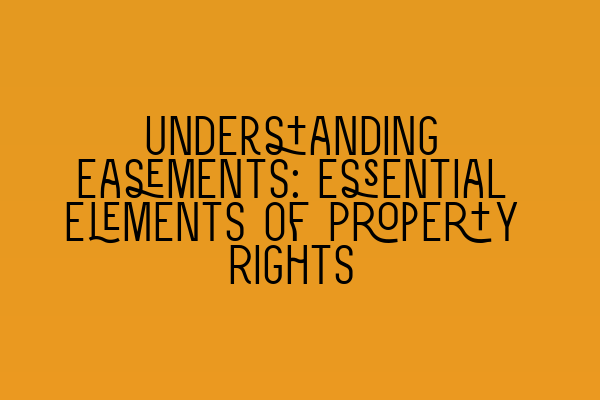Understanding Easements: Essential Elements of Property Rights
When it comes to property law, there are various rights and interests that individuals can hold over a piece of land. One such right is an easement, which grants a person or entity certain rights to use someone else’s property for a specific purpose. Easements play a crucial role in ensuring that individuals can enjoy their properties in a way that meets their needs, while also respecting the rights of others. In this article, we will delve into the essential elements of easements and shed light on this important aspect of property rights.
1. What is an Easement?
An easement is a non-possessory interest in another person’s land that entitles the holder of the easement to a specific use or enjoyment of that land. It is important to note that an easement does not grant ownership or possession of the land itself, but rather a limited right to use or access the land for a particular purpose.
2. Common Types of Easements
There are several common types of easements that can arise in property law. Some of the most frequent types include:
– Right of Way: This type of easement allows a person to pass through another person’s property, usually for purposes such as access to a public road or neighboring property.
– Utility Easement: A utility company may hold an easement to install and maintain utility lines on private property. This ensures that necessary infrastructure can be installed and maintained while respecting the property rights of landowners.
– Drainage Easement: A drainage easement allows for the flow of water across a property to prevent flooding or water buildup. This type of easement is commonly found in areas prone to heavy rainfall or in properties with natural drainage patterns.
– Conservation Easement: A conservation easement is put in place to protect a property’s natural features or historical importance. It restricts certain activities on the property to preserve its conservation value.
3. The Essential Elements of an Easement
To establish a valid easement, certain elements must be present:
– Dominant and Servient Tenements: An easement requires two properties – the dominant tenement (the property that benefits from the easement) and the servient tenement (the property that is burdened by the easement). These properties must be distinct and separate entities.
– Grant or Prescription: An easement may be created explicitly through a written agreement or deed, in which case it is referred to as a “granted easement.” Alternatively, an easement may arise through prescription, which occurs when a person has continuously used another’s property for a specific purpose for a certain period of time, as prescribed by law.
– Appurtenant or In Gross: An easement can be either appurtenant or in gross. An appurtenant easement benefits the owner of a specific property, while an easement in gross benefits a specific individual or entity. Appurtenant easements are said to “run with the land” and transfer with the property when it is sold or otherwise transferred.
4. Creation and Termination of Easements
Easements can be created through various means, including express grants, agreements, or legal documents. They can also be acquired through adverse possession or long-term use. However, it is important to understand that an easement can also be terminated or extinguished under certain circumstances, such as abandonment, release, merger, or legal action.
5. Importance of Easements in Property Transactions
Easements play a critical role in property transactions and can significantly impact a property’s value and potential use. When buying or selling a property, it is essential to thoroughly understand any existing easements and their implications. An easement may restrict the use or development of a property, or conversely, enhance its value by allowing for critical access or utility services.
Understanding easements and their essential elements is crucial for navigating property transactions, negotiations, and disputes. Whether you are a property owner, buyer, or developer, having a comprehensive understanding of easements will help you make informed decisions and protect your property rights.
For further insights into property law and related topics, we invite you to explore the following articles:
– SQE Contract Law: Analyzing Landmark Cases and Influential Judicial Decisions
– Understanding Contractual Capacity: Rights and Limitations
– Interactive SQE Mock Tests for Contract Law: Test Your Knowledge
– Join Our SQE Contract Law Webinars: Expert Insights and Guidance
– SQE Prep: Mastering the Essentials of Contract Law
At SQE Property Law & Land Law, our team of expert solicitors is dedicated to providing comprehensive legal advice and guidance on all aspects of property law. Whether you need assistance with easements, conveyancing, or property disputes, our experienced professionals are here to help. Contact us today to schedule a consultation and ensure your property rights are protected.
